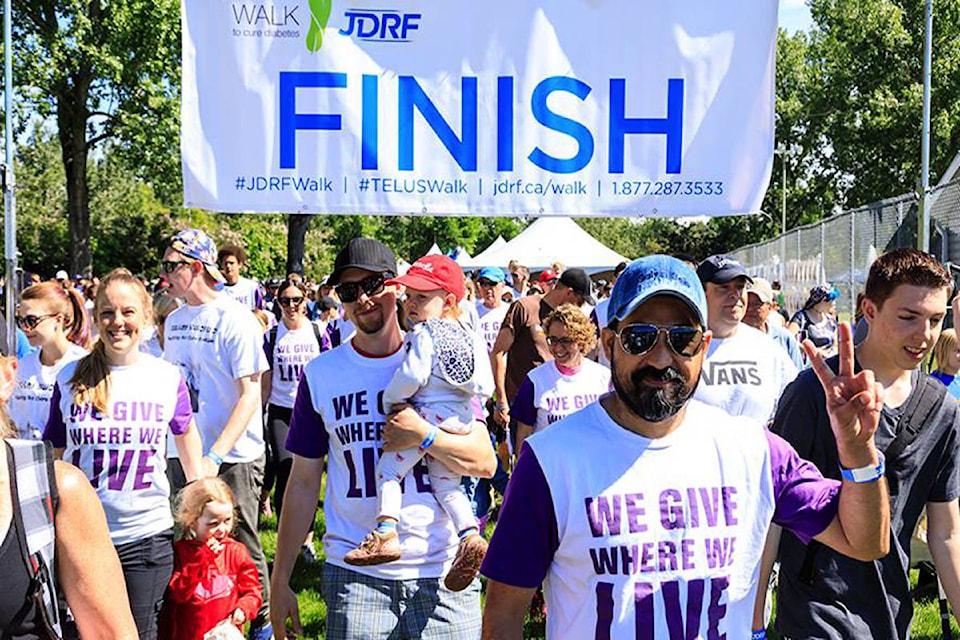Registration is open for the 2018 Juvenile Diabetes Research Foundation (JDRF) Walk to Cure Diabetes, which is happening in both Cranbrook and Kelowna on June 10. The free, fun, activity-packed event takes place here at Rotary Park.
JDRF was founded in 1970, the Canadian branch in 1974, with their primary focus being raising money for type 1 diabetes (T1D). To date they have contributed over $2 billion to a broad spectrum of studies that have substantially advanced treatment and management of the disease. They have staff and volunteers in more than 100 locations around the world and each year contribute around $75 million to support diabetes research.
Close to Cranbrook, there are also events held in Kelowna and Kamloops, and here in the East Kootenay we typically see around 50 to 150 people come out to support it and raise anywhere between $5,000 and $25,000. Kimberley resident Ken Green, who has a daughter with T1D is the lead volunteer for the East Kootenay.
It is estimated that about 300,000 people in Canada are currently living with T1D today.
“We know that even though 80 per cent of people are diagnosed as children, the vast majority of people who are living with the disease are adults,” said Shannon Jolley, manager of fundraising and development for JDRF. “Since the discovery of insulin we’ve been able to keep people alive, trouble is is the disease is still really, really difficult. It’s very devastating for families.”
The disease requires those who are afflicted by it to essentially perform the job that their pancreas is supposed to be able to do. They must manually manage their own blood-sugar levels by eating and administering insulin to keep themself in a healthy blood-sugar level.
It is extremely time consuming and fraught with danger. Parents of children with T1D face persistent dilemmas with what to pack their child for lunch and how to balance that with insulin.
“As well these mums that never sleep through the night because you have to test your child’s blood sugar in the middle of the night, if you don’t you could wake up and your kid could be dead or in a coma. So it’s a really difficult disease, it’s more common that you would think.”
Jolley also stressed the important point that type 1 is very distinct from type 2. Type 2 frequently occurs with older people who may have unhealthy lifestyle habits; with poor diets, sedentary lifestyles and a lack of exercise. As a result they develop T2D — their bodies can no longer turn sugar into energy.
T1D is an autoimmune disease, in the same category as Multiple Sclerosis or rheumatoid arthritis. It is not caused by something the person did, it is a genetic fluke, and it is known that someone who had type 1 in their family would be more likely to get it than someone who doesn’t.
“So the people who have type one they’re constantly feeling that public shame where people think ‘oh well they must have done something to cause this’ and really they haven’t. They are victims of a disease of a genetic quirk that has nothing to do with the way that they’re living their life.”
Jolley said that one of the things JDRF tries to do is provide opportunities for people with the disease to come together and share experience, knowledge and support. “The type 1 community is healthier when we’re all connected,” she said.”
In order to facilitate this connection, the organization hosts what they call “Device Nights” where representatives from medical technology companies come and demonstrate the latest and greatest products available to minimize the side effects and complications associated with T1D.
Omnipod, Medtronic, Dexcom and Abbot (Freestyle Libre) will bring opportunities to see their products and ask questions in an informal, trade-show setting. The first is happening in Nelson on April 24 and they are currently working to solidify the venue and date for Cranbrook, but it will occur around May 9 or 10.
Just one of the examples of medical technology available for demonstration is a metre, a device that helps to eliminate finger pricking. People with T1D have to test their blood sugar constantly, eight to 10 times a day at least, and it can cause callouses to form on the finger tips. These new metres are worn on the body, with something that goes under your skin that readings can be drawn from.
“You can wear those ones for a little bit longer, so one of the Freestyle Libres, you can take your reader and you just kind of wand it over and it will give you a blood sugar reading, so you can get your blood sugar reading any time without having to prick your finger.”
For the past ten years, Telus was the title sponsor of the Walk to Cure Diabetes, but last year was their last, and as a result they are having to reinvent themselves for 2018’s Walk. This year they are excited to announce that Max Domi, NHL player and son of Tie Domi, is their national spokesperson.
“We have a brand new volunteer committee, a brand new set of energy, and we’re really excited about reenergizing, rebirthing this event this year to turn it into something really amazing,” Jolley said.
The event is free to attend, the organization just asks that people register at www.jdrfwalk.ca to help fundraise by sharing the information on their Facebook pages, sending out emails and then using that portal to try and collect donations from friends and family.
